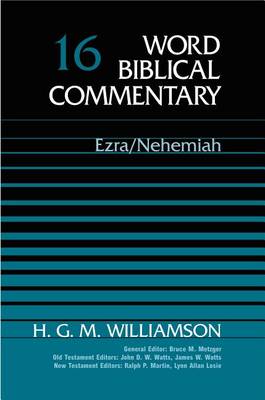Word Biblical Commentary
3 total works
The books of Ezra and Nehemiah are vital and significant records of times as tumultuous as our own, as Israel returned from the Babylonian captivity and undertook the rebuilding of the Temple, even while beset by enemies without and dissension within the community.
For the student of the post-exilic period of biblical history and thought, a detailed knowledge of both books -along with the companion history in the Chronicles is essential, says Dr. H. G. M. Williamson.
Based on years of intensive study and research, this new commentary provides competent guidance into the complexities of Ezra and Nehemiah. The author gives special attention to the perplexing scholarly problems associated with their form, structure, and literary history. Supporting the view that much of this material is from the fifth century B.C., just as it claims to be, he concludes that "there is good reason to approach Ezra and Nehemiah as two parts of single work and that this work is to be regarded as complete as it stands."
Dr. Williamson also focuses on sections of these books commonly referred to as the "Ezra Memoir" and the "Nehemiah Memoir." He notes the specifically theological purpose of such sections, in which the rebuilding of Jerusalem and the Temple are defended against the enemies, and the leaders of Israel plead for recognition of their faithfulness to the commission given them by God through the Persian kings.
The integrity and balance in Dr. Williamson's methods, approach, and goals are apparent throughout this commentary, which strives always to give exegesis the greatest prominence rather than impose foreign, a priori categories of interpretation on the material.
The Word Biblical Commentary delivers the best in biblical scholarship, from the leading scholars of our day who share a commitment to Scripture as divine revelation. This series emphasizes a thorough analysis of textual, linguistic, structural, and theological evidence. The result is judicious and balanced insight into the meanings of the text in the framework of biblical theology. These widely acclaimed commentaries serve as exceptional resources for the professional theologian and instructor, the seminary or university student, the working minister, and everyone concerned with building theological understanding from a solid base of biblical scholarship.
Overview of Commentary Organization
- Introduction—covers issues pertaining to the whole book, including context, date, authorship, composition, interpretive issues, purpose, and theology.
- Each section of the commentary includes:
- Pericope Bibliography—a helpful resource containing the most important works that pertain to each particular pericope.
- Translation—the author’s own translation of the biblical text, reflecting the end result of exegesis and attending to Hebrew and Greek idiomatic usage of words, phrases, and tenses, yet in reasonably good English.
- Notes—the author’s notes to the translation that address any textual variants, grammatical forms, syntactical constructions, basic meanings of words, and problems of translation.
- Form/Structure/Setting—a discussion of redaction, genre, sources, and tradition as they concern the origin of the pericope, its canonical form, and its relation to the biblical and extra-biblical contexts in order to illuminate the structure and character of the pericope. Rhetorical or compositional features important to understanding the passage are also introduced here.
- Comment—verse-by-verse interpretation of the text and dialogue with other interpreters, engaging with current opinion and scholarly research.
- Explanation—brings together all the results of the discussion in previous sections to expose the meaning and intention of the text at several levels: (1) within the context of the book itself; (2) its meaning in the OT or NT; (3) its place in the entire canon; (4) theological relevance to broader OT or NT issues.
- General Bibliography—occurring at the end of each volume, this extensive bibliographycontains all sources used anywhere in the commentary.


